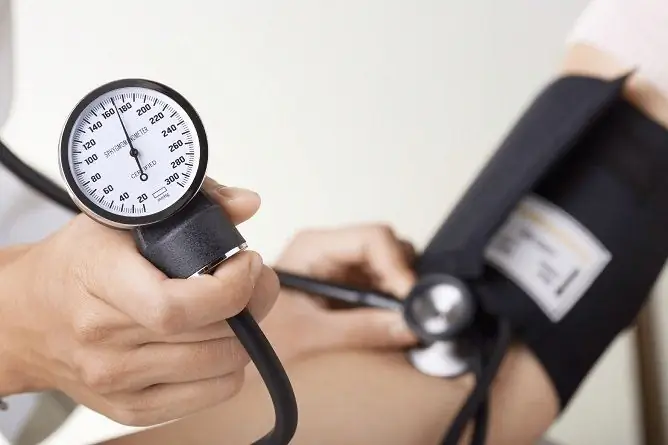- Author Rachel Wainwright [email protected].
- Public 2023-12-15 07:39.
- Last modified 2025-11-02 20:14.
Arterial hypertension
The content of the article:
- Risk factors
- Forms of the disease
- Stages of arterial hypertension
- Symptoms
- Diagnostics
- Hypertension treatment
- Potential consequences and complications
- Forecast
- Prevention of arterial hypertension
Arterial hypertension is a disease characterized by high blood pressure (over 140/90 mm Hg), which has been recorded repeatedly. The diagnosis of arterial hypertension is made on the condition that high blood pressure (BP) is recorded in the patient at least three measurements taken against the background of a calm environment and at different times, provided that the patient did not take any medications that could increase or decrease it …

Arterial hypertension is a common chronic disease in adults associated with high blood pressure
Arterial hypertension is diagnosed in about 30% of middle-aged and elderly people, but it can also be observed in adolescents. The average incidence rate for men and women is almost the same. Among all forms of the disease, moderate and light accounts for 80%.
Arterial hypertension is a serious medical and social problem, as it can lead to the development of dangerous complications (including myocardial infarction, stroke), which can cause permanent disability, as well as death.
Risk factors
The main role in the development of arterial hypertension belongs to violations of the regulatory function of the higher parts of the central nervous system, which control the functions of all internal organs and systems, including the cardiovascular system. That is why arterial hypertension most often develops in people who are often overworked mentally and physically, subject to strong nervous shocks. Harmful working conditions (noise, vibration, night shifts) are also risk factors for the development of arterial hypertension.
Other factors predisposing to the development of arterial hypertension:
- A family history of hypertension. The likelihood of developing the disease increases several times in people who have two or more blood relatives suffering from high blood pressure.
- Lipid metabolism disorders both in the patient himself and in his immediate family.
- Diabetes mellitus in a patient or his parents.
- Kidney disease.
- Obesity.
- Alcohol abuse, smoking.
- Salt abuse. The consumption of more than 5.0 g of table salt per day is accompanied by fluid retention in the body and spasm of arterioles.
- Sedentary lifestyle.
In the climacteric period in women, against the background of hormonal imbalance, nervous and emotional reactions are aggravated, increasing the risk of developing arterial hypertension. According to statistics, in about 60% of women, the disease occurs precisely with the onset of menopause.

Arterial hypertension is a frequent companion of obese people
The age factor influences the risk of arterial hypertension in men. Before the age of 30, the disease develops in 9% of men, and after 65 years, almost every second suffers from it. Up to 40 years of age, arterial hypertension is more often diagnosed in men; in the older age group, the incidence in women increases. This is due to the fact that after forty years in the body of women hormonal changes begin, associated with the onset of menopause, as well as the high mortality of middle-aged and older men from complications of arterial hypertension.
The pathological mechanism of the development of arterial hypertension is based on an increase in the resistance of peripheral blood vessels and an increase in cardiac output. Under the influence of a stress factor, the regulation of the medulla oblongata and the hypothalamus of peripheral vascular tone is disrupted. This leads to spasm of arterioles, the development of dyscirculatory and dyskinetic syndromes.
Spasm of arterioles increases the secretion of hormones of the renin-angiotensin-aldosterone group. Aldosterone is directly involved in mineral metabolism, contributes to the retention of sodium and water ions in the patient's body. This, in turn, contributes to an increase in circulating blood volume and an increase in blood pressure.
Against the background of arterial hypertension, the patient has an increase in blood viscosity. As a result, the blood flow rate decreases, and metabolic processes in the tissues deteriorate.
Over time, the walls of the blood vessels thicken, which narrows their lumen and increases the level of peripheral resistance. At this stage, arterial hypertension becomes irreversible.
Further development of the pathological process is accompanied by an increase in permeability and plasma saturation of the walls of blood vessels, the development of arteriolosclerosis and elastofibrosis, causing secondary changes in various organs and tissues. Clinically, this is manifested by primary nephroangiosclerosis, hypertensive encephalopathy, and sclerotic changes in the myocardium.
Forms of the disease
Depending on the cause, essential and symptomatic arterial hypertension are distinguished.
Essential (primary) hypertension occurs in about 80% of cases. The reason for the development of this form of the disease cannot be established.

Types of arterial hypertension
Symptomatic (secondary) hypertension occurs as a result of damage to organs or systems involved in the regulation of blood pressure. Most often, secondary arterial hypertension develops against the background of the following pathological conditions:
- kidney disease (acute and chronic pyelo- and glomerulonephritis, obstructive nephropathy, polycystic kidney disease, kidney connective tissue disease, diabetic nephropathy, hydronephrosis, congenital renal hypoplasia, renin-secreting tumors, Liddle syndrome);
- uncontrolled long-term use of certain medications (oral contraceptives, glucocorticoids, antidepressants, sympathomimetics, nonsteroidal anti-inflammatory drugs, lithium preparations, ergot preparations, cocaine, erythropoietin, cyclosporine);
- endocrine diseases (acromegaly, Itsenko-Cushing's syndrome, aldosteronism, congenital adrenal hyperplasia, hyper- and hypothyroidism, hypercalcemia, pheochromocytoma);
- vascular diseases (renal artery stenosis, coarctation of the aorta and its main branches);
- complications of pregnancy;
- neurological diseases (increased intracranial pressure, brain tumors, encephalitis, respiratory acidosis, sleep apnea, acute porphyria, lead poisoning);
- surgical complications.
Stages of arterial hypertension
To determine the degree of arterial hypertension, it is necessary to establish normal blood pressure values. In people over 18 years of age, the pressure is considered normal if it does not exceed 130/85 mm Hg. st.. Pressure 135-140 / 85-90 - borderline between norm and pathology.
According to the level of increase in blood pressure, the following stages of arterial hypertension are distinguished:
- Light (140-160 / 90-100 mm Hg) - the pressure increases under the influence of stress and physical exertion, after which it slowly returns to normal values.
- Moderate (160-180 / 100-110 mm Hg) - BP fluctuates throughout the day; signs of damage to internal organs and the central nervous system are not noted. Hypertensive crises are rare and mild.
- Severe (180-210 / 110-120 mm Hg). This stage is characterized by hypertensive crises. During a medical examination, patients are diagnosed with transient cerebral ischemia, left ventricular hypertrophy, increased serum creatinine, microalbuminuria, narrowing of the retinal arteries.
- Extremely severe (over 210/120 mm Hg). Hypertensive crises occur frequently and are difficult. Serious tissue damage develops, leading to organ dysfunction (chronic renal failure, nephroangiosclerosis, dissecting aneurysm of blood vessels, edema and hemorrhages of the optic nerve, cerebral vascular thrombosis, cardiac left ventricular failure, hypertensive encephalopathy).
Along the course, arterial hypertension can be benign or malignant. The malignant form is characterized by the rapid progression of symptoms, the addition of severe complications from the cardiovascular and nervous systems.
Symptoms
The clinical course of arterial hypertension is variable and is determined not only by the level of increased blood pressure, but also by which target organs are involved in the pathological process.
For the early stage of arterial hypertension, disorders of the nervous system are characteristic:
- transient headaches, most often localized in the occipital region;
- dizziness;
- a feeling of pulsation of blood vessels in the head;
- noise in ears;
- sleep disorders;
- nausea;
- palpitations;
- fatigue, lethargy, feeling of weakness.
With further progression of the disease, in addition to the above symptoms, shortness of breath is added, which occurs during physical exertion (climbing stairs, running or brisk walking).

Headaches and dizziness are the main symptoms of arterial hypertension
Increase in blood pressure over 150-160 / 90-100 mm Hg. Art. manifested by the following signs:
- dull pain in the region of the heart;
- numbness of the fingers;
- muscle tremor resembling chills;
- redness of the face;
- excessive sweating.
If arterial hypertension is accompanied by fluid retention in the body, then puffiness of the eyelids and face, swelling of the fingers are added to the listed symptoms.
Against the background of arterial hypertension, patients experience a spasm of the retinal arteries, which is accompanied by deterioration of vision, the appearance of spots in the form of lightning and flies before the eyes. With a significant increase in blood pressure, hemorrhage into the retina may occur, resulting in blindness.
Diagnostics
The examination program for arterial hypertension is aimed at the following goals:
- Confirm the presence of a stable increase in blood pressure.
- Identify possible damage to target organs (kidney, heart, brain, organ of vision), assess their degree.
- Determine the stage of arterial hypertension.
- Assess the likelihood of complications.
Collecting anamnesis, special attention is paid to clarifying the following questions:
- the presence of risk factors;
- the level of increased blood pressure;
- the duration of the disease;
- the frequency of occurrence of hypertensive crises;
- the presence of concomitant diseases.

Diagnosis of arterial hypertension consists in measuring blood pressure over time
If arterial hypertension is suspected, blood pressure should be measured over time with the obligatory observance of the following conditions:
- the measurement is carried out in a calm atmosphere, giving the patient 10-15 minutes for adaptation;
- an hour before the upcoming measurement, the patient is advised not to smoke, not drink strong tea or coffee, not to eat, not to instill in the eyes and nose drops containing sympathomimetics;
- when measuring, the patient's hand should be at the same level with the heart;
- the lower edge of the cuff should be 2.5-3 cm above the cubital fossa.
During the first examination of the patient, the doctor measures the blood pressure on both hands twice. Wait 1-2 minutes before re-measuring. If there is a pressure asymmetry exceeding 5 mm Hg. Art., then all further measurements are carried out on the hand with high rates. In cases where there is no asymmetry, measurements should be made on the left hand for right-handers and on the right hand for left-handers.
Patients suffering from arterial hypertension must learn to measure blood pressure on their own, this allows better control over the course of the disease.
Laboratory diagnostics for arterial hypertension includes:
- Rehberg test;
- urine analyzes according to Nechiporenko and Zimnitsky;
- triglycerides, total blood cholesterol;
- blood creatinine;
- blood glucose;
- blood electrolytes.
In case of arterial hypertension, patients must undergo an electrocardiographic study in 12 leads. The obtained data, if necessary, are supplemented with the results of echocardiography.
Patients with established arterial hypertension should be consulted by an ophthalmologist, with a mandatory fundus examination.
To assess target organ damage, perform:
- Ultrasound of the abdominal organs;
- computed tomography of the kidneys and adrenal glands;
- aortography;
- excretory urography;
- electroencephalography.
Hypertension treatment
Therapy of arterial hypertension should be aimed not only at normalizing elevated blood pressure, but also at correcting existing disorders of the internal organs. The disease is chronic in nature, and although complete recovery in most cases is impossible, properly selected treatment of arterial hypertension prevents the further development of the pathological process, reduces the risk of hypertensive crises and severe complications.

With arterial hypertension, a salt-free diet is indicated.
With arterial hypertension, it is recommended:
- adherence to a diet with restriction of table salt and a high content of magnesium and potassium;
- refusal to drink and smoke;
- normalization of body weight;
- increasing the level of physical activity (walking, physiotherapy exercises, swimming).
Medical treatment of arterial hypertension is prescribed by a cardiologist, it requires a long time and periodic correction. In addition to antihypertensive drugs, according to indications, diuretics, antiplatelet agents, β-blockers, hypoglycemic and hypolipidemic agents, sedatives or tranquilizers are included in the therapy regimen.
The main indicators of the effectiveness of the treatment of arterial hypertension are:
- lowering blood pressure to a level well tolerated by the patient;
- lack of progression of damage to target organs;
- prevention of the development of complications from the cardiovascular system, which can significantly worsen the patient's quality of life or cause death.
Potential consequences and complications
Long-term or malignant course of arterial hypertension leads to significant damage to the arterioles of target organs (eyes, heart, kidneys, brain) and instability of their blood circulation. As a result, a persistent increase in blood pressure provokes the onset of myocardial infarction, cardiac asthma or pulmonary edema, ischemic or hemorrhagic stroke, retinal detachment, dissecting aortic aneurysms, chronic renal failure.
Arterial hypertension, especially of a severe course, is often complicated by the development of a hypertensive crisis (episodes of a sudden sharp increase in blood pressure). The development of a crisis is provoked by mental stress, a change in meteorological conditions, and physical fatigue. Clinically, a hypertensive crisis is manifested by the following symptoms:
- significant increase in blood pressure;
- dizziness;
- intense headache;
- increased heartbeat;
- feeling hot;
- nausea, vomiting, which may be repeated;
- visual disturbances (flashing "flies" in front of the eyes, loss of visual fields, darkening in the eyes, etc.);
- cardialgia.
Against the background of a hypertensive crisis, disturbances of consciousness occur. Patients can be disoriented in time and space, frightened, agitated, or, conversely, inhibited. In a severe course of the crisis, consciousness may be absent.

Long-term consequences of arterial hypertension
A hypertensive crisis can lead to acute left ventricular failure, acute cerebrovascular accident (ischemic or hemorrhagic stroke), myocardial infarction.
Forecast
The prognosis for arterial hypertension is determined by the nature of the course (malignant or benign) and the stage of the disease. Factors that worsen the prognosis are:
- rapid progression of signs of damage to target organs;
- III and IV stages of arterial hypertension;
- severe damage to the blood vessels.
An extremely unfavorable course of arterial hypertension is observed in young people. They have a high risk of stroke, myocardial infarction, heart failure, sudden death.
With an early start of treatment for arterial hypertension and subject to the patient's careful observance of all the recommendations of the attending physician, it is possible to slow down the progression of the disease, improve the quality of life of patients, and sometimes achieve long-term remission.
Prevention of arterial hypertension
Primary prevention of arterial hypertension is aimed at preventing the development of the disease and includes the following measures:
- giving up bad habits (smoking, drinking alcoholic beverages);
- psychological relief;
- proper balanced nutrition with limitation of fats and table salt;
- regular moderate physical activity;
- long walks in the fresh air;
- refusal to abuse caffeine-rich drinks (coffee, cola, tea, tonics).
With already developed arterial hypertension, prevention is aimed at slowing the progression of the disease and preventing the development of complications. This prophylaxis is called secondary prophylaxis and includes patient adherence to doctor's prescriptions for both drug therapy and lifestyle modifications, as well as regular monitoring of blood pressure.
YouTube video related to the article:

Elena Minkina Doctor anesthesiologist-resuscitator About the author
Education: graduated from the Tashkent State Medical Institute, specializing in general medicine in 1991. Repeatedly passed refresher courses.
Work experience: anesthesiologist-resuscitator of the city maternity complex, resuscitator of the hemodialysis department.
The information is generalized and provided for informational purposes only. At the first sign of illness, see your doctor. Self-medication is hazardous to health!






